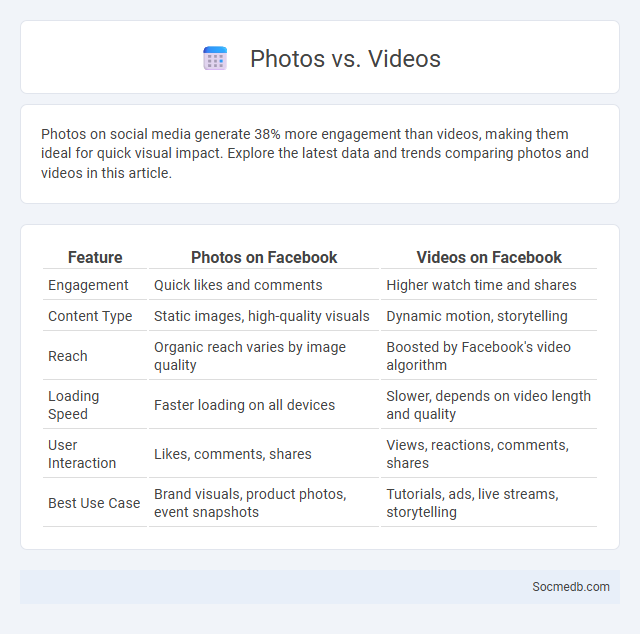
Photo illustration: Photos vs Videos
Photos on social media generate 38% more engagement than videos, making them ideal for quick visual impact. Explore the latest data and trends comparing photos and videos in this article.
Table of Comparison
| Feature | Photos on Facebook | Videos on Facebook |
|---|---|---|
| Engagement | Quick likes and comments | Higher watch time and shares |
| Content Type | Static images, high-quality visuals | Dynamic motion, storytelling |
| Reach | Organic reach varies by image quality | Boosted by Facebook's video algorithm |
| Loading Speed | Faster loading on all devices | Slower, depends on video length and quality |
| User Interaction | Likes, comments, shares | Views, reactions, comments, shares |
| Best Use Case | Brand visuals, product photos, event snapshots | Tutorials, ads, live streams, storytelling |
Understanding Photos, Videos, and Viral Content
Leveraging the power of social media requires a deep understanding of photos, videos, and viral content, as visuals trigger higher engagement and emotional connections. Your success depends on creating compelling, shareable content that resonates with your target audience by emphasizing authenticity, storytelling, and relatability. Analyzing trends, audience behavior, and platform algorithms helps optimize content for maximum reach and virality.
Key Differences Between Photos and Videos
Photos capture a single moment with high detail and clarity, making them ideal for showcasing specific subjects or messages instantly. Videos, however, provide dynamic storytelling through motion and sound, engaging your audience with unfolding narratives and emotional depth. Understanding these key differences helps you choose the right format to enhance your social media presence effectively.
The Power of Visual Storytelling
Visual storytelling on social media harnesses the impact of images and videos to evoke emotions and convey messages more effectively than text alone. Platforms like Instagram and TikTok thrive on compelling visuals that increase user engagement, enhance brand recognition, and drive viral sharing. Leveraging visual content with strategic captions and hashtags can significantly boost audience reach and create memorable, authentic connections.
Why Some Content Goes Viral
Content goes viral on social media due to a combination of emotional resonance, shareability, and timing. Posts that trigger strong emotions such as joy, surprise, or anger are more likely to be shared extensively. Algorithms on platforms like Facebook, Instagram, and TikTok amplify content with high engagement, increasing its visibility and potential to reach viral status.
Engagement Metrics: Photos vs Videos
Videos on social media generate 120% more engagement than photos, with users spending an average of 2.6 seconds longer watching video content compared to viewing static images. Engagement metrics such as likes, shares, and comments consistently show higher interaction rates for videos, especially on platforms like Instagram and Facebook where video posts receive 38% more engagement than photo posts. Brands leveraging video content report a 54% increase in overall engagement, emphasizing the importance of dynamic visual media in social media marketing strategies.
Social Media Algorithms and Content Reach
Social media algorithms prioritize content based on user engagement, relevance, and personalization to maximize your content reach. These algorithms analyze factors like likes, comments, shares, and viewing time to determine which posts appear on your followers' feeds. Understanding and optimizing content for these algorithms can significantly enhance visibility and audience interaction.
When to Use Photos, Videos, or Aim for Virality
Choosing between photos, videos, or viral content depends on your social media goals and audience engagement patterns. Photos work best for quick impressions and brand recognition, while videos offer deeper storytelling and longer viewer retention, increasing your content's impact. If your goal is to maximize reach and interactions, crafting content with viral potential leverages trending topics and emotional appeal to connect with You and your target audience effectively.
Tips for Creating Viral Content
Crafting viral social media content involves understanding trending topics and leveraging emotional appeal to engage audiences effectively. Incorporate visually compelling media such as high-quality photos, videos, or infographics that resonate with target demographics and encourage sharing. Utilize data-driven strategies like analyzing peak engagement times and using platform-specific hashtags to increase visibility and reach.
Measuring Success: Analytics and Insights
Social media success hinges on leveraging analytics and insights to track engagement, reach, and conversion rates effectively. Utilizing tools such as Facebook Insights, Twitter Analytics, and Instagram Insights allows you to gather detailed data on audience behavior and content performance. Your ability to interpret these metrics informs strategy adjustments that enhance brand visibility and drive targeted interactions.
Future Trends in Visual and Viral Content
Emerging trends in visual and viral content on social media emphasize immersive experiences through augmented reality (AR) and virtual reality (VR) integrations, enhancing user engagement and interaction. Short-form video formats, spearheaded by platforms like TikTok and Instagram Reels, continue to dominate, driven by algorithmic personalization and creative storytelling techniques. The increasing use of AI-generated content and deep learning enables hyper-personalized visuals, boosting virality and brand reach across diverse demographics.
 socmedb.com
socmedb.com